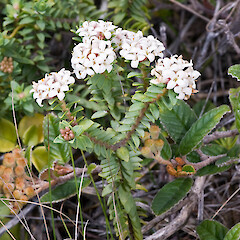Pimelea sporadica
Synonyms
Pimelea laevigata Sol. ex Gaertn. pro parte
Family
Thymelaeaceae
Flora category
Vascular – Native
Endemic taxon
Yes
Endemic genus
No
Endemic family
No
Structural class
Trees & Shrubs - Dicotyledons
Current conservation status
The conservation status of all known New Zealand vascular plant taxa at the rank of species and below were reassessed in 2017 using the New Zealand Threat Classification System (NZTCS) – more information about this can be found on the NZTCS website. This report includes a statistical summary and brief notes on changes since 2012 and replaces all previous NZTCS lists for vascular plants.
Please note, threat classifications are often suggested by authors when publications fall between NZTCS assessment periods – an interim threat classification status has not been assessed by the NZTCS panel.
- Conservation status of New Zealand indigenous vascular plants, 2017 . 2018. Peter J. de Lange, Jeremy R. Rolfe, John W. Barkla, Shannel P. Courtney, Paul D. Champion, Leon R. Perrie, Sarah M. Beadel, Kerry A. Ford, Ilse Breitwieser, Ines Schönberger, Rowan Hindmarsh-Walls, Peter B. Heenan and Kate Ladley. Department of Conservation. Source: NZTCS and licensed by DOC for reuse under the Creative Commons Attribution 4.0 International licence.
2017 | At Risk – Naturally Uncommon | Qualifiers: RR
Previous conservation statuses
2012 | At Risk – Naturally Uncommon | Qualifiers: RR
2009 | Data Deficient
2004 | Range Restricted
Brief description
Small shrub to 45cm tall with erect white-hairy branches bearing pairs of green fleshy poking out leaves, hairy white flowers and white fruit inhabiting coastal northern North Island south to East Cape. Leaves 4.5-6.5mm long by 3-3.7mm, cupped, underside shiny, leaves underneath flowers larger.
Distribution
Endemic. North Island: Te Paki (North Cape) to Cape Brett, Bay of Islands and near Maunganui Bluff. East Cape at Hicks Bay.
Habitat
Coastal headlands and rock outcrops (ultramafic, sandstone and basalt), in low scrub or on bare ground, also on consolidated sand. Most common on ultramafic rocks at North Cape.
Detailed description
A medium-sized, erect to suberect shrub, to 450 mm high. Branches stiff, divergent. Branching both sympodial and lateral but the former is most notable. Branchlets moderately densely covered by short, grey-white hair. Internodes 1.5–3.0 mm long. Older stems glabrous, grey-brown. Node buttresses short (0.2 mm) dark brown, lunate, masked by hair on young branchlets, moderately prominent on leafless branches. Leaves decussate, crowded on young branches, ascendant at first, then mainly patent and becoming deflexed, on very short (0.1–0.2 mm) red petioles, or sessile. Lamina relatively thick, stiff, ovate to oblong, 4.5–6.5 × 3.0–3.7 mm, glabrous, medium-green, glaucous, slightly keeled, or adaxially concave, margins slightly upturned, midvein not plainly evident abaxially, slightly sunken, acute, base cuneate or truncate. Stomata on adaxial surface only. Abaxial surface glistens. Inflorescences 3–6-flowered, terminal on leading branches, sometimes clustered. Involucral bracts 4, larger than adjacent leaves (7 × 5 mm). Receptacles very hairy, pedicels 0.2 mm, persistent. Plants gynodioecious. Flowers white, covered in short, moderately dense hair outside; inside hairless; calyx lobes opening in salverform fashion. Female tube 3 mm long, ovary portion 2.1 mm, calyx lobes 1.2 × 0.8 mm; hermaphrodite tube 4 mm long, ovary portion 2.2 mm, calyx lobes 2.5 × 2.0 mm. Anther dehiscence semi-latrorse. Ovary with a sparse hair-covering at summit. Fruits broad-ovoid, fleshy white, opaque 4.5 × 3.4 mm. Seeds narrow-ovoid 2 × 1.4 mm.
Similar taxa
Pimelea sporadica is allied to P. telura of the Three Kings Islands from which it differs by its smaller stature (plants up to 400 mm cf. 1.0 m tall) and smaller leaves whose undersides that are adaxially concave or keeled
Flowering
September - April
Flower colours
White
Fruiting
October - April
Propagation technique
Easily grown from semi-hardwood cuttings. An attractive species that does best in a well drained, fertile soil. It should be planted in a sunny situation. Plants are intolerant of shade.
Threats
Listed by de Lange et al. (2009: N.Z.J.Bot. 47: 61–96) as Pimelea aff. tomentosa (b) (AK 130893; Surville cliffs) and awarded the status of Tax. Indet. Naturally Uncommon. Burrows (2009) has expanded the concept of this species and suggests that it is secure at North Cape but vulnerable elsewhere, again without supporting evidence. As such this species status is probably better referred to as Data Deficient until better information becomes available.
Etymology
pimelea: Pimeleoides means “resembling Pimelea’’, a genus in the family Thymelaeaceae (Greek, -oides = resembling, like).
Where To Buy
Not commercially available.
Attribution
Description from: Burrows (2009)
References and further reading
Description from: Burrows, C.J. 2009: Genus Pimelea (Thymelaeaceae) in New Zealand 2. The endemic Pimelea prostrata and Pimelea urvilliana species complexes. New Zealand Journal of Botany 47: 163–229.











